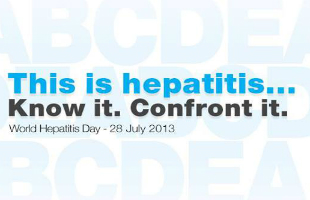
On World Hepatitis Day (28 July), the World Health Organization (WHO) is urging governments to act against the five hepatitis viruses that can cause severe liver diseases and lead to 1.4 million deaths every year. Some of these hepatitis viruses, most notably types B and C, can also lead to chronic and debilitating illnesses such as liver cancer and cirrhosis. In addition they lead to loss of income and high medical expenses for hundreds of millions of people worldwide.
“The fight against hepatitis is a public health priority,” says Dr Shin Young-soo, WHO Regional Director for the Western Pacific. "Governments and health authorities must scale up successful interventions, develop new approaches and mobilize all resources necessary to adequately address the burden and challenges caused by hepatitis."
In Viet Nam, an estimated 8.6 million people are chronically infected with hepatitis B virus. Liver cancer is one of the leading causes of death in men. People who inject drugs have a particularly high prevalence of hepatitis C infection, with up to 98.5% of them infected with the virus.
Viral hepatitis is a group of infectious diseases causing inflammation of the liver. There are five main types of hepatitis virus—A, B, C, D and E— which affect hundreds of millions of people worldwide. Only hepatitis B and C virus can cause chronic infections. An estimated 500 million people are chronically infected with hepatitis B virus or hepatitis C virus. Approximately 1 million people die each year (approximately 2.7% of all deaths) from causes related to viral hepatitis, most commonly cirrhosis and liver cancer. An estimated 57% of cases of liver cirrhosis and 78% of cases of primary liver cancer result from hepatitis B virus or hepatitis C virus infection.
The transmission paths of the different hepatitis viruses vary. Hepatitis B, C and D are contracted through the blood of an infected person and, in the case of hepatitis B and C, also through unprotected sex. Hepatitis A and E are typically transmitted via contaminated water or food.
Viral hepatitis is usually preventable, treatable and often curable. If they know their status, people at risk for chronic hepatitis B and C can protect themselves and others. Most chronic hepatitis B infections are acquired during birth or early childhood. These can be prevented with vaccination at birth followed by at least two more doses. These doses of vaccine effectively decrease that child’s risk of developing chronic hepatitis later in life.
In Viet Nam, routine immunization for hepatitis B has been implemented for the past ten years. In 2011, fifty-five percent of newborns received a dose of hepatitis B vaccination at birth, and the coverage for the additional three dose vaccination reached 95%. According to a 2011 survey, this resulted in a reduction of hepatitis B infection in children aged five in Viet Nam to approximately two percent. Vietnam is moving toward the next control goal in 2017 of <1% prevalence in 5 year old children.
Reducing the risk of infection with hepatitis C requires avoiding unsafe injections, improving hospital infection control and promoting safe blood transfusion practice. Harm reduction programmes used to prevent HIV in people who inject drugs, such as needle, syringe and condom distribution, are also critical to prevent the transmission of hepatitis C.
WHO is currently developing new global guidelines on hepatitis C screening, care and treatment. The guidelines are expected to promote treatment for viral hepatitis C. Hepatitis medicines are now included in the WHO Essential Medicines List, which countries are encouraged to adopt. At the same time, hepatitis medicines must become more accessible and affordable.
References
Leandro Sereno, Fabio Mesquita, Masaya Kato, David Jacka, Thi Thuy Van Nguyen, and Thien Nga Nguyen. “Epidemiology, Responses, and Way Forward: The Silent Epidemic of Viral Hepatitis and HIV Coinfection in Vietnam” Journal of the International Association of Physicians in AIDS Care. Abstract available at http://jia.sagepub.com/content/early/2012/07/24/1545109712453939.abstract
Nguyen VTT, Law MG, Dore MG. An enormous HBV-related liver disease burden projected in Vietnam by 2025. Liver International 2008, 28:525-531. Abstract available at : http://www.ncbi.nlm.nih.gov/pubmed/18266635
